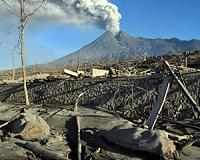| . |  |
. |
Paris (AFP) Nov 17, 2010 The eruption of Eyjafjoell, the Icelandic volcano which grounded flights across Europe this year, followed a long, threatening warm-up in which the mountain growled and its icy flanks bulged, scientists said on Wednesday. Vulcanologists from the United States, Iceland, Sweden and the Netherlands used satellite images and data from Global Positioning System (GPS) movement monitors to build a step-by-step tableau of events. "Several months of unrest preceded the eruptions, with magma moving around downstairs in the plumbing and making noise in the form of earthquakes," said Kurt Feigl, a professor of geosciences at the University of Wisconsin at Madison. The eruption of Eyjafjoell -- the first since 1821-1823 -- disgorged a cloud of ash which affected more than 100,000 flights and eight million passengers. Reporting in the British journal Nature, the scientists said they stepped up their watch in mid-2009, when a GPS station on the south side of the volcano suddenly pointed to movement of between 10 and 12 millimetres (about 0.4 of an inch). By January, the volcano was being shaken by several seismic episodes a day, signalling the inflow of magma into its roots. Eventually, the sides of the volcano bulged by more than 15 centimetres (six inches) before the first eruption began on March 20. It took almost a month for the volcano to start to deflate, which is a surprise given that volcanoes "shrink," rather like a poorly-knotted balloon, as molten rock and scorching gases flow from the chamber. On April 14, after two days of quiet, a second eruption occurred in which lava broke out through a channel under the ice on the mountain's summit. This caused an "explosive" reaction as water flashed to steam and gas escaped from bubbles in the magma. The result was an ash plume that rose to heights of up to 9,000 metres (nearly 30,000 feet), causing misery for millions of stranded air travellers. The scientists said they were unsure why Eyjafjoell erupted when it did. One idea is that magma intruded into the volcano's heart through a network of conduits and chambers. "The explosiveness of the eruption depends on the type of magma, and the type of magma depends on the depth of its sources," said Feigl. "We're a long way from being able to predict eruptions, but if we can visualise the magma as it moves upward inside the volcano, then we'll improve understanding of the processes driving volcanic activity."
Share This Article With Planet Earth
Related Links Bringing Order To A World Of Disasters When the Earth Quakes A world of storm and tempest
 Indonesians ignore volcano threat to go home
Indonesians ignore volcano threat to go homeSukoharjo, Indonesia (AFP) Nov 15, 2010 With their belongings piled on to motorcycles and pickup trucks, thousands of Indonesian families returned home on Monday after fleeing deadly volcanic eruptions from Mount Merapi. Scientists warned however that the nation's most active volcano remained a severe threat, as more bodies were found buried in the mountains of ash blasted out from Mount Merapi since late last month, bringing the ... read more |
|
| The content herein, unless otherwise known to be public domain, are Copyright 1995-2010 - SpaceDaily. AFP and UPI Wire Stories are copyright Agence France-Presse and United Press International. ESA Portal Reports are copyright European Space Agency. All NASA sourced material is public domain. Additional copyrights may apply in whole or part to other bona fide parties. Advertising does not imply endorsement,agreement or approval of any opinions, statements or information provided by SpaceDaily on any Web page published or hosted by SpaceDaily. Privacy Statement |